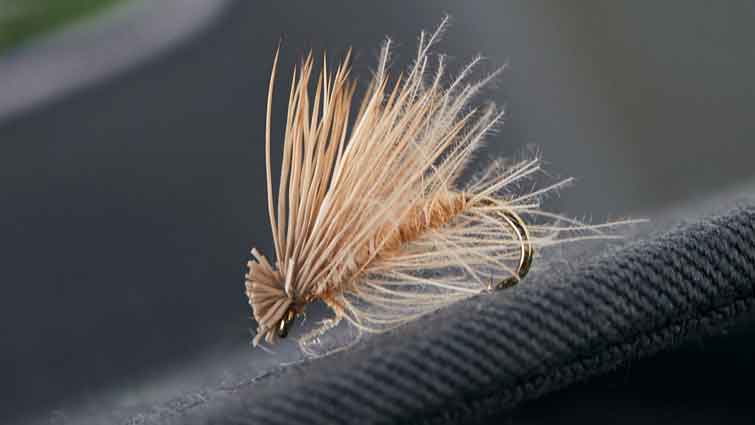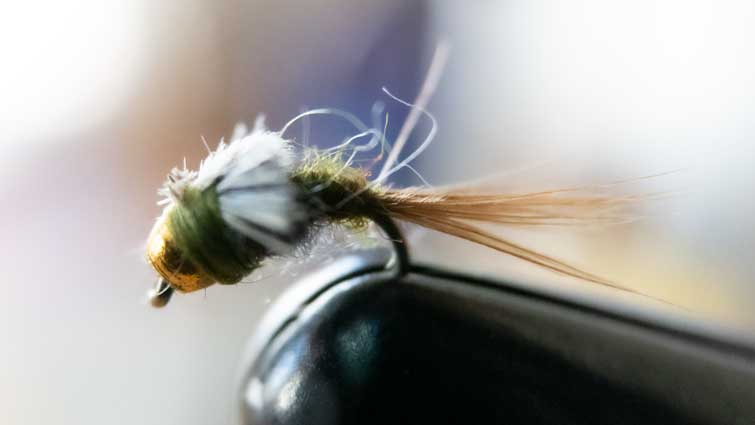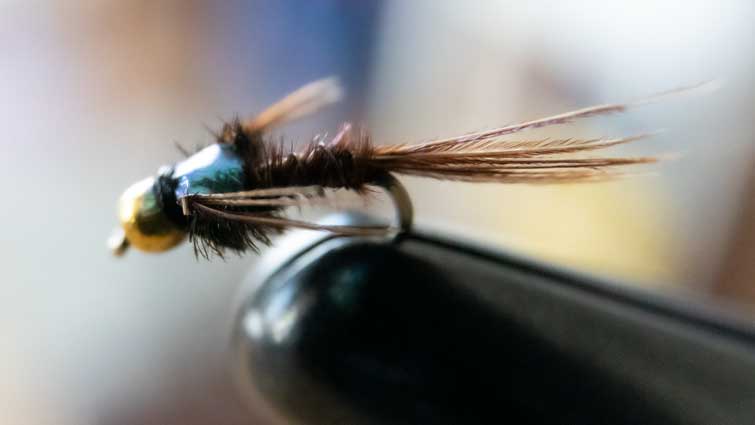Rainbow trout can be found in rivers and lakes all over the world, most commonly in the United States. There are several types of flies that resemble small insects, larvae, or crayfish, which rainbow trout love to eat.
We recommend matching the hatch but also going smaller on flies for larger, more pressured trout, but these are typically 5 of the Best Flies for Catching Rainbow Trout:
- Parachute Adams
- Elk Hair Caddis
- Gold Ribbed Hare's Ear
- Pheasant Tail
- Rainbow Warrior Nymph
In this article, we'll go over each of the five flies mentioned above and what they are designed to imitate. Keep this in mind; the more realistic the fly appears to be (like a bug or insect) can make all the difference when you're fishing for trout!

Rainbow Trout Fly Fishing in the U.S.
Trout have a highly developed sense of sight, especially regarding movement, making brightly colored flies a productive choice. Flies tied with feathers work well because they look a lot like many of the insects that trout eat.
Rainbow trout, including steelhead varieties, typically lay eggs in early to late spring (January to June in the Northern Hemisphere and September to November in the Southern Hemisphere), when water temperatures are at least 42 to 44 degrees Fahrenheit (6 to 7 degrees Celsius).

The optimum time to fish for trout is between dawn and 2 hours after sunrise, followed by late afternoon from 3 hours before sunset until dusk.
When it comes to the color and size of the fly to use, there is no hard and fast rule when it comes to trout, therefore utilize patterns with many hues so you may replicate all of the various life stages in their diet and sizes between 12-22 will cover most situations.
Parachute Adams
The Parachute Adams is one of the top 5 flies for catching trout and can be used in many different situations. This fly is used on rivers or lakes, not just one over the other. This fly looks very similar to a mayfly nymph which is something trout eat all of the time! Another reason this might be one of your favorite flies because it can withstand lots of abuse from big fish.

Typically sizes 12-18 are best. Even when caddis are hatching, instead of mayflies, the Adams will draw strikes. When midges are emerging, it's also hard to top a tiny Adams in sizes 20-24.
The Parachute Adams has been a favorite of fly fishermen since it was first created. The Adams gets its name because it imitates an adult mayfly, which floats on the water's surface with its wings spread to dry after emerging from the water.
The Elk Hair Caddis
The Elk Hair Caddis belongs in the top 5, but it can also be used as more than just a fly for rainbow trout. This fly's unique design helps prevent drag when fishing fast-moving water and also makes it easier for you to detect strikes through its use of deer hair that mimics the feel of an insect hitting the surface on the bug’s first jump out of the water.

The Elk Hair Caddis is a favorite caddis imitation to use. It works great during any time of year, including the winter months. Even though it might look complicated, there are several DIY versions out there that anyone can try at home! The Elk hair caddis only requires a few materials and can be constructed in under 20 minutes.
Gold Ribbed Hare's Ear
The Gold Ribbed Hare's Ear is another one of our recommended flies to use, but it also works for many other types of fish too! This fly is known as a classic attractor pattern but can be used in any situation when you are targeting rainbow trout. It is another excellent option if you are fishing smaller streams where the fish are selective because of their realistic appearance and ability to catch fish in low light conditions or high-pressure situations.

What makes this nymph so great is the fact that it imitates a lot of different insects at one time, making it attractive to many types of trout. For example, the body looks similar to a worm or grub, while the wing case on top resembles an insect called order Ephemeroptera (which includes mayflies).
Pheasant Tail Nymph
The Pheasant Tail Nymph imitates midges, one of the most attractive insects for trout. This fly is also one of the most widely used nymphs because it works in almost every situation! If you are fishing a larger lake or reservoir, fast-flowing freestone river, low gradient coastal streams, or even spring creeks, this might be the option for you.

The Pheasant Tail Nymph's popularity is due to its effectiveness. It is an excellent general-purpose nymph that can be used for a variety of species, including trout. It closely resembles the natural insect because it has a slender shape, resembling small worms and grubs more than any other type of insect.
Depending on where you live, the Pheasant Tail Nymph could make up much of your fly box - because it works in all conditions! If you fish for trout in lakes or freestone rivers, this might be one of your go-to options anytime you need to add some extra weight (or want to mimic something smaller).
Rainbow Warrior Nymph
The Rainbow Warrior Nymph is another great option for catching trout! It's an effective generalist pattern that imitates many types of aquatic larval insects, including midge larvae and other small crustaceans. The tungsten bead helps get this fly to the desired depth quickly, which will help you catch more fish during your next outing to rainbow locations around the world!

The Rainbow Warrior Nymph is a great option to have in your trout fly box - especially if you fish for rainbows in rivers. This fly is designed to be fished deep, and its heavyweight will help you get it down fast!
Other Flies recommended for catching rainbow trout :
- Caddis Pupa
- Copper John
- Beadhead Prince Nymph
- Blue-Winged Olive
Rainbow Trout Flies- Matching The Hatch
The fish will consume whatever insect life is available at the time, including both larvae and adults. Trout's diet consists of a specific style. They'll swim around with their mouths open, rubbing their bodies against the bottom of a river, lake, or stream.
The best approach to solve the problem is to match the hatch; trout will eat everything that is hatching. The trout's eye is more sensitive to the red wavelength than a person's, and it has less capacity to detect green than any other color. The appropriate flies should be based on both color and hatch.
Trout feed on various insects and other invertebrates such as:
- Caddisflies
- Stoneflies
- Mayflies
- Midges
- Annelids (worms)

When choosing what color to fly fish with, bring a selection of nymphs so you will have a variety of colors to choose from. Use dark-colored patterns when fishing murky water and light-colored flies when there is good visibility on the surface. In clear water situations, use more contrasting colors on your fly fishing flies, such as white on black or vice versa, for deepwater applications where sight is not as effective.
You'll want to make sure that your fly fishing flies match the hatch by using natural-looking materials like feathers and fur-like synthetics. If possible, use fly fishing flies that aren't too bright.
Do Rainbow Trout Eat Flies?
The most popular flies for catching rainbow trout are Adams dry flies, which imitate most aquatic insects that trout eat. A dry fly that successfully imitates the natural insect is called a "nymph imitation" because it resembles an insect underwater in its nymphal stage.

Trout consume a wide range of aquatic insects, terrestrial invertebrates, crustaceans, leeches, worms, and other foods. The aquatic insects that spend most of their life cycles underwater in rivers, streams, and still waters are the most essential food sources for trout and fly fishers.
Most popular flies for catching trout are tied with lighter-colored hackle to represent the pupa or emergent stages of mayfly hatches. More rarely, they are also tied to resemble larvae or eggs, known as larval imitations. Emergers are typically more difficult to in fast-moving water currents but may be used in slow-moving deep pools.
What Is the Best Size Fly for Trout?
Going smaller on flies for larger, more pressured trout will give you more action and make the fish come up more often. Most trout like to eat nymphs or emergers in slow-moving pools with lots of feeding lanes.
We recommend matching the hatch and going smaller on flies for larger, more pressured trout, especially in tailwaters. Trout prefer nymph flies, streamers, and dry flies. Dry flies 12-16 are ideal for brown trout; wet flies 12-22 are also good choices.

What Are Rainbow Trout Attracted To?
A rainbow trout likes cold water with large rocks and aquatic vegetation for protection while spawning. Although different species of rainbow trout can be found in many climates, they prefer cool weather with plenty of rain and open water when spawning.
Rainbow trout are drawn to various hues, including white, gold, brown, green, black, silver, pink, orange, yellow and red. Matching the hatch is recommended when fishing for rainbow trout. It is also important to use any other pattern or color that corresponds with the trout's food.

The best type of fly for rainbow trout is a nymph imitation, which are commonly made from peacock herl or pheasant tail fibers with an adhesive coating. This design is excellent because it's very lightweight and allows you to cast the fly a long way when needed.
What Type of Flies Do Rainbow Trout Eat?
Rainbow trout, like all fish, consume a wide range of foods. In the beginning, they eat aquatic insects such as caddisflies, mayflies, and midges to their diet. They start eating small fish as they mature but continue to consume larvae and adults.
Rainbow trout feed on mayflies, midges, and caddisflies. These insects are accessible to the fish throughout all stages of life: eggs, larvae, nymphs, and adults.

A fly pattern that imitates these natural creatures is a good choice for fishing trout streams. The imitation must be as close as possible in color and size to the actual insect. Trout will notice even the smallest imperfection between your fly and its counterpart in nature.
What Type of Flies Do Rainbow Trout Like?
Brown trout prefer wet flies, streamers, and dry flies such as Adams dry flies or Elk Hair caddis dry flies. Dry flies 12-16 are ideal for brown trout; wet flies 12-18 are also good choices.
If you're looking for what do rainbow trout eat, your best bet is to try fly fishing flies that look like caddisflies or mayflies. You can also use surface bugs, leech patterns, and wets with bead heads. Use darker colors when stream conditions are murky and lighter colors when the visibility on the surface of clear water is good.

Professionals suggest changing patterns regularly when fishing for them if they stop feeding on your current artificial fly color after a period of time has passed since you first presented it to them. Artificial flies in darker colors work best when there is little or no wind at all. Bright colors are best when there's a lot of wind, especially in the mornings and evenings.
To get the best success when fly fishing for rainbow trout, you should always try to match the hatch; this may require using multiple fly fishing flies at once or changing them regularly if and when trout stop feeding on your current color.
Rainbow trout are found all over the world, so there is no one fly to use. We recommend matching the hatch but also going smaller on flies for larger, more pressured trout.

About the Author
Matthew Bernhardt, a third-generation Coloradan, grew up at the forefront of the state’s fly-fishing revolution, enjoying time on the water side by side with experienced guides and lifelong anglers.
By combining his passion for fly-fishing with input from other experienced fly-fishers and guides and his fine arts degree from Colorado State University, Matthew spent five years carefully developing the Drifthook Fly Fishing System, built to help every angler catch more trout.
When he’s not spending time with his wonderful family, you’ll find him out on the water catching MONSTER trout, and he anxiously looks forward to the day when his kids are old enough to join him there.




